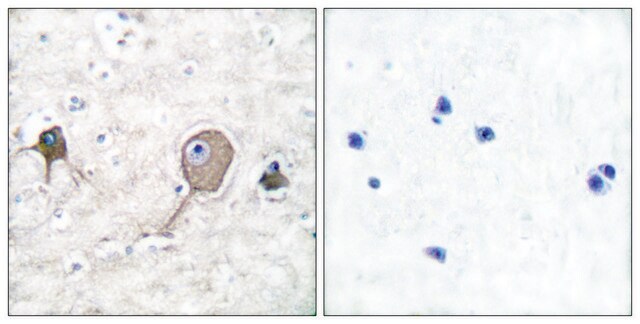SAB4200571
Anti-Neuron-Specific Enolase (NSE), Mouse monoclonal
clone NSE-P1, purified from hybridoma cell culture
Synonym(e):
Anti-2-phospho-D-glycerate hydrolyase, Anti-Enolase 2 (gamma, neuronal), Anti-NSE, Anti-Neural enolase, Anti-gamma-enolase, Monoclonal Anti-2-phospho-D-glycerate hydro-lyase
About This Item
Empfohlene Produkte
Biologische Quelle
mouse
Konjugat
unconjugated
Antikörperform
purified from hybridoma cell culture
Antikörper-Produkttyp
primary antibodies
Klon
NSE-P1, monoclonal
Form
buffered aqueous solution
Mol-Gew.
antigen ~47 kDa
Speziesreaktivität
human, rat, mouse
Konzentration
~1.0 mg/mL
Methode(n)
immunohistochemistry: 10-20 μg/mL using formalin-fixed paraffin embedded human cerebellum.
western blot: 0.5-1.0 μg/mL using NTERA-2 (NT2/D1) total cell extracts.
Isotyp
IgG1
UniProt-Hinterlegungsnummer
Versandbedingung
dry ice
Lagertemp.
−20°C
Posttranslationale Modifikation Target
unmodified
Angaben zum Gen
human ... ENO2(2026)
Allgemeine Beschreibung
Spezifität
Immunogen
Anwendung
- immunofluorescence staining
- immunocytochemistry
- immunofluorescence microscopy
- immunoblotting
- enzyme-linked immunosorbent assay (ELISA)
- immunohistochemistry
Immunocytochemistry (1 paper)
Biochem./physiol. Wirkung
Physikalische Form
Lagerung und Haltbarkeit
Haftungsausschluss
Sie haben nicht das passende Produkt gefunden?
Probieren Sie unser Produkt-Auswahlhilfe. aus.
Lagerklassenschlüssel
10 - Combustible liquids
Flammpunkt (°F)
Not applicable
Flammpunkt (°C)
Not applicable
Analysenzertifikate (COA)
Suchen Sie nach Analysenzertifikate (COA), indem Sie die Lot-/Chargennummer des Produkts eingeben. Lot- und Chargennummern sind auf dem Produktetikett hinter den Wörtern ‘Lot’ oder ‘Batch’ (Lot oder Charge) zu finden.
Besitzen Sie dieses Produkt bereits?
In der Dokumentenbibliothek finden Sie die Dokumentation zu den Produkten, die Sie kürzlich erworben haben.
Unser Team von Wissenschaftlern verfügt über Erfahrung in allen Forschungsbereichen einschließlich Life Science, Materialwissenschaften, chemischer Synthese, Chromatographie, Analytik und vielen mehr..
Setzen Sie sich mit dem technischen Dienst in Verbindung.






